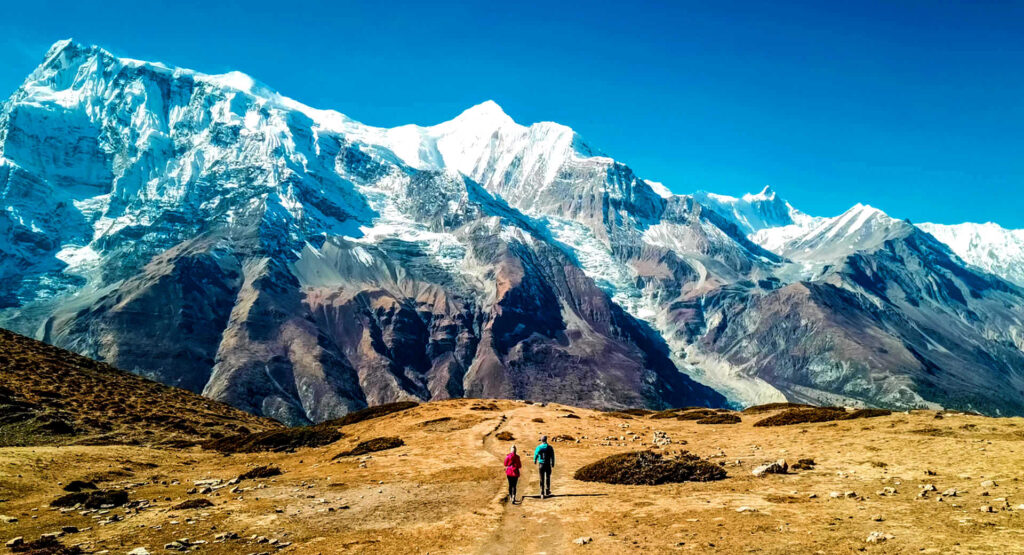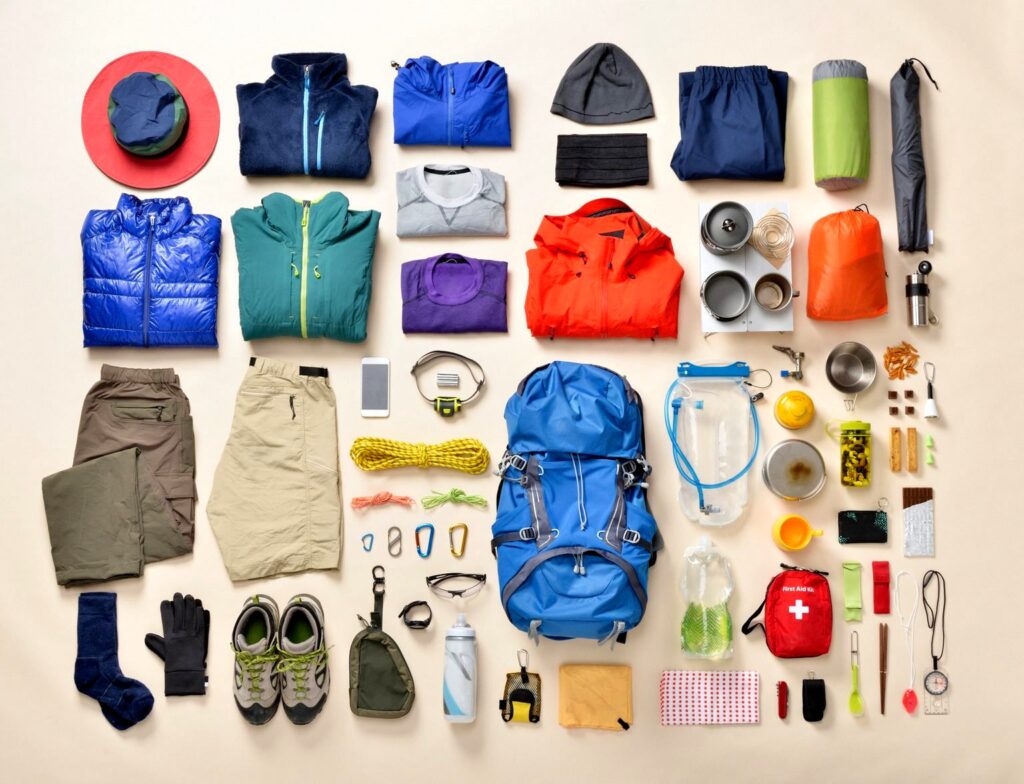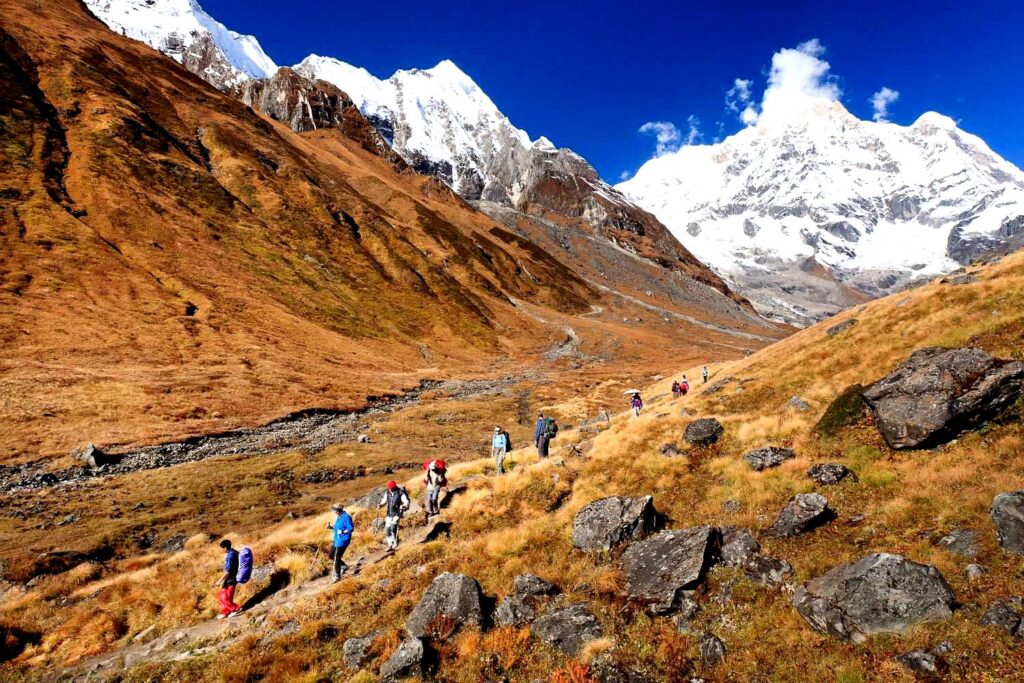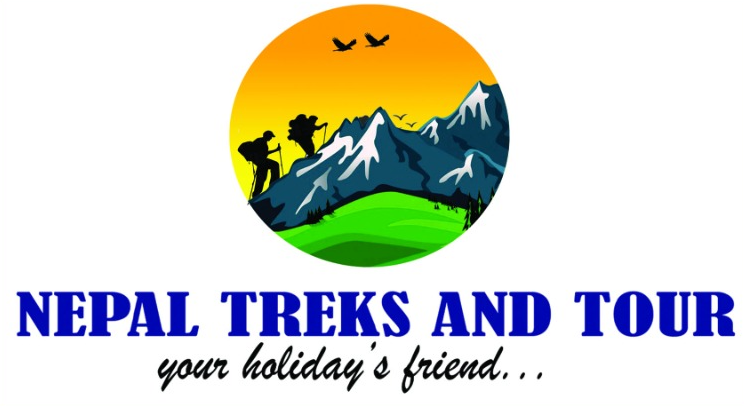The Annapurna Circuit Trek is one of the most legendary and rewarding trekking routes in the world, circling the majestic Annapurna Massif and offering an incredible diversity of landscapes, cultures, and adventure. From lush subtropical forests and terraced rice fields to high alpine valleys and the windswept desert-like terrain near Thorong La Pass, this trek presents a dramatic and ever-changing panorama at every step. Ideal for trekkers seeking both physical challenge and cultural immersion, the Annapurna Circuit combines natural beauty with authentic Himalayan village life. In this complete guide by Nepal Treks and Tour, we’ll walk you through everything you need to know about the Annapurna Circuit Trek itinerary, trek difficulty, weather conditions, trekking permits, accommodation, and the best tips to ensure a safe and unforgettable journey through one of Nepal’s most iconic trekking routes.
Why Choose the Annapurna Circuit Trek?
- Diverse Landscapes: Trek through subtropical forests, alpine meadows, glacial valleys, and arid highlands—all in one journey.
- Stunning Mountain Views: Enjoy panoramic vistas of Annapurna I, Dhaulagiri, Manaslu, Tilicho Peak, and more.
- Cultural Immersion: Experience both Hindu and Tibetan Buddhist cultures, with traditional villages, monasteries, and centuries-old customs.
- Iconic High-Altitude Pass: Conquer the world-famous Thorong La Pass trek at 5,416 meters—one of the highest trekking passes in the world.
- Flexible Itinerary: The Annapurna Circuit Trek itinerary is customizable in terms of days, detours, and pace.
- Teahouse Trekking Experience: Comfortable Annapurna Circuit tea house trekking lets you enjoy local hospitality and hearty mountain meals.
- Challenging but Achievable: A perfect trek for those seeking moderate-to-challenging adventure without needing technical climbing.
- Safe & Scenic Acclimatization: Ideal for proper Annapurna Circuit acclimatization, especially around Manang and Yak Kharka.
- Adventure & Accessibility: Offers high-altitude thrills without being too remote—easily accessible from Kathmandu and Pokhara.
Trek Overview
The Annapurna Circuit Trek is a classic Himalayan adventure that circles the entire Annapurna Massif, covering a vast and diverse range of ecosystems, ethnic communities, and dramatic landscapes. Stretching between 160 to 230 kilometers depending on the route, this trek takes you from lush lowland villages through dense forests and river valleys, ascending to high alpine meadows and over the iconic Thorong La Pass at 5,416 meters. Along the way, trekkers are rewarded with breathtaking views of Annapurna I, Dhaulagiri, Manaslu, and Tilicho Peak, while experiencing rich cultural encounters in both Hindu and Tibetan Buddhist settlements. With its blend of natural beauty, cultural richness, and physical challenge, the Annapurna Circuit Trek remains one of the most rewarding and unforgettable experiences for anyone passionate about trekking in Nepal.
Annapurna Circuit Trek Itinerary

Day 01: Arrival in Kathmandu (1,400m)
- Welcome to Nepal! Upon arrival, our team will greet you at Tribhuvan International Airport and transfer you to your hotel. In the evening, you’ll attend a pre-trek briefing.
Day 02: Drive to Besisahar (760m) then to Jagat (1,300m) – 8-9 hrs
- A scenic drive west from Kathmandu through hills, rivers, and local villages. You’ll switch to a jeep in Besisahar for a bumpy ride to Jagat, the starting point of the trek.
Day 03: Trek to Dharapani (1,860m) – 5-6 hrs
- Trek through lush forests, suspension bridges, and charming villages. Enjoy views of waterfalls and traditional stone houses along the Marsyangdi River.
Day 04: Trek to Chame (2,610m) – 5-6 hrs
- The trail ascends steadily through pine forests and into cooler climates. Reach Chame, the district headquarters of Manang, with beautiful mountain views.
Day 05: Trek to Pisang (3,300m) – 5-6 hrs
- Walk through a dramatic landscape of dense woods and deep river gorges. The views of Annapurna II and Paungda Danda rock face are truly breathtaking.
Day 06: Trek to Manang (3,540m) – 6-7 hrs
- Choose between the lower or upper Pisang route (upper offers better views). Arrive in the picturesque village of Manang surrounded by the towering peaks.
Day 07: Acclimatization Day in Manang
- Rest and explore nearby viewpoints or take a short hike to Gangapurna Lake or the Bhojo Gompa to aid your Annapurna Circuit acclimatization before climbing higher.
Day 08: Trek to Yak Kharka (4,050m) – 4-5 hrs
- Trek higher into alpine landscapes with herds of yaks and stunning mountain vistas. The trail gradually climbs along the valley.
Day 09: Trek to Thorong Phedi (4,525m) – 4-5 hrs
- A short but high-altitude day, getting you closer to the dramatic Thorong La Pass. Stay overnight at the base camp.
Day 10: Cross Thorong La Pass (5,416m) – Trek to Muktinath (3,800m) – 7-8 hrs
- The most challenging and rewarding day! Start early to cross Thorong La Pass, the highest point of the trek, then descend to the sacred pilgrimage site of Muktinath.
Day 11: Trek to Jomsom (2,720m) – 5-6 hrs
- Descend through the arid Kali Gandaki valley. Enjoy views of Dhaulagiri before reaching the windy town of Jomsom, the administrative center of the Mustang region.
Day 12: Fly to Pokhara (827m) – 20 min flight
- Take a short scenic flight over the Himalayas to the lakeside city of Pokhara. Rest, relax, and enjoy the city’s vibrant energy.
Day 13: Drive or Fly Back to Kathmandu – 6 hrs drive / 25 min flight
- Return to the capital, either by scenic drive or a quick domestic flight. Enjoy a farewell dinner with our team.
Day 14: Final Departure
- After breakfast, we’ll transfer you to the airport for your departure or onward journey.
Accommodation & Meals
Accommodation:
- Tea House Lodging: Throughout the Annapurna Circuit Trek, you’ll stay in locally-run tea houses—basic yet comfortable lodges that offer twin-sharing rooms with beds, blankets, and sometimes attached bathrooms.
- Cities (Kathmandu & Pokhara): Comfortable 3-star (or optional 4/5-star) hotels with private rooms and modern amenities.
- Communal Areas: Most tea houses have a central dining area with a wood-burning stove—a cozy spot to relax and socialize.
Meals:
Full-Board During Trek: All meals—breakfast, lunch, and dinner—are provided during trekking days.
Typical Dishes Include:
- Dal Bhat (lentil soup, rice, vegetables) – local favorite
- Noodles and Pasta
- Vegetable curries
- Momos (Tibetan dumplings)
- Tibetan Bread, eggs, porridge, and pancakes for breakfast
Drinks: Herbal teas, hot lemon, ginger honey tea, and bottled or purified water (available at cost).
Special Notes:
- Vegetarian Options: Easily available and widely recommended at higher altitudes.
- Snacks: Bring your own energy bars, chocolates, or trail mix for long walking days.
- Alcohol: Avoid alcohol during the trek, especially at high altitudes—it affects acclimatization.
Guide and Porter During the Annapurna Circuit Trek
Professional Guide:
- Licensed & Experienced: Your Annapurna Circuit Trek guide is a government-certified professional with years of experience in the Himalayas.
- English-Speaking: Fluent in English and knowledgeable about local culture, geography, flora, fauna, and altitude-related safety.
- Altitude & Safety Expert: Trained in first aid, altitude sickness management, and emergency evacuation protocols.
- Supportive Companion: Guides are not only route experts but also your motivator, cultural interpreter, and local connection throughout the trek.
Friendly Porter:
- Load Carrier: Porters carry your duffel bags (up to 15–20 kg per trekker) so you can enjoy the trek with just a light daypack.
- Hardworking & Respected: We ensure porters are fairly treated, insured, well-fed, properly equipped, and paid fairly.
- Locals from the Region: Many porters are from villages along the Annapurna Circuit, offering authentic insights into the region.
Important Note:
- Pack Smart: Use soft duffel bags (provided by us) and keep essentials in your daypack (water, snacks, camera, jacket).
- Ethical Trekking: We follows responsible trekking practices, ensuring the well-being and dignity of all staff.
Trekking Permits for the Annapurna Circuit Trek
Embarking on the Annapurna Circuit Trek requires obtaining two essential permits to ensure a safe and regulated journey through Nepal’s stunning landscapes:
Annapurna Conservation Area Permit (ACAP)
Purpose: Grants access to the Annapurna Conservation Area, supporting conservation efforts and sustainable tourism.
Cost:
- Foreign Nationals: NPR 3,000 (approximately USD 25)
- Validity: Single entry; valid for the duration of the trek.
Where to Obtain:
- Kathmandu: Nepal Tourism Board Office, Bhrikutimandap
- Pokhara: Nepal Tourism Board Office, Damside
- Besisahar: ACAP Permit Counter
Trekkers’ Information Management System (TIMS) Card
Purpose: Maintains a database of trekkers to enhance safety and security.
Cost:
- Foreign Nationals: NPR 2,000 (approximately USD 17)
- Validity: Single entry; valid for the duration of the trek.
Where to Obtain:
- Kathmandu: Trekking Agencies Association of Nepal (TAAN) Office, Maligaon
- Pokhara: TAAN Office, Damside
Required Documents for Permit Application
To apply for the Annapurna Circuit Trek permits, ensure you have:
- A valid passport with a Nepal visa
- Two passport-sized photos
- A detailed trek itinerary
- Emergency contact information (both local and home country)
Important Notes
- Permit Checks: Carry your permits at all times; they will be checked at various points along the trek.
- Solo Trekkers: As of April 2023, solo trekking without a licensed guide is prohibited in Nepal. Our registered Annapurna Circuit Trek guide is mandatory.
- Fines: Trekking without the required permits can result in fines and expulsion from the conservation area.
For a hassle-free experience, consider booking your trek with Nepal Treks and Tour. We handle all permit arrangements, ensuring compliance with regulations and a smooth start to your adventure.
Insurance for the Annapurna Circuit Trek
Why It’s Essential:
- The Annapurna Circuit Trek takes you above 5,000 meters with potential risks including altitude sickness, injuries, or unforeseen weather delays.
- In emergencies, helicopter evacuation may be the only rescue option—insurance coverage is mandatory to cover these high costs.
What Your Insurance Should Cover:
- Emergency Medical Evacuation (especially via helicopter)
- High-Altitude Sickness Treatment (coverage up to 6,000 meters minimum)
- Accidents & Injuries (including trekking-related)
- Trip Cancellation & Interruption
- Lost Baggage & Gear
- Delays Due to Weather or Natural Disasters
Tips:
- Always read the fine print to ensure coverage includes high-altitude trekking and Nepal.
- Keep a copy of your insurance policy and emergency contacts with you and your Annapurna Circuit Trek guide.
- Make sure to specify that you’re doing the Thorong La Pass trek, which reaches 5,416 meters.
We do not provide insurance, but we require all trekkers to submit proof of travel insurance before starting the Annapurna Circuit Trek for your safety and peace of mind.
Essential Trekking Gear for Annapurna Circuit Trek

Clothing (Layering is Key)
- Base Layers: Moisture-wicking thermal tops and bottoms (2 sets)
- Insulating Layer: Fleece or down jacket (lightweight but warm)
- Outer Layer: Waterproof and windproof shell jacket and pants (Gore-Tex or similar)
- Trekking Pants: Lightweight, quick-drying
- Trekking Shirts: Long and short-sleeved (quick-dry)
- Warm Jacket: Heavy down jacket for high-altitude days
- Gloves: Inner liner gloves + insulated waterproof gloves
- Hat: Warm wool/fleece beanie + sun hat with wide brim
- Neck Gaiter or Buff: For dust, cold, and wind protection
Footwear
- Hiking Boots: Waterproof, broken-in with good ankle support
- Camp Shoes/Sandals: For evenings and teahouse comfort
- Trekking Socks: Moisture-wicking and thermal (3–4 pairs)
- Gaiters (optional): For snow or muddy trails
Backpacks & Bags
- Daypack (25–35L): For personal items (rain cover included)
- Duffel Bag (60–80L): Carried by porter (provided by us)
- Dry Bags/Stuff Sacks: For organizing and waterproofing gear
Sleeping
- Sleeping Bag: Rated at -10°C or lower (can be rented or provided)
- Sleeping Bag Liner: Optional for extra warmth and hygiene
Toiletries & Personal Care
- Toothbrush, toothpaste, soap, hand sanitizer
- Quick-dry towel
- Sunscreen (SPF 50+), lip balm with SPF
- Wet wipes and tissue/toilet paper
- Menstrual hygiene products (if applicable)
Health & Safety
- Personal First-Aid Kit: Include medication for headaches, diarrhea, altitude sickness, blisters, etc.
- Water Purification: Tablets, SteriPEN, or filter bottles
- Headlamp: With extra batteries
- Sunglasses: UV-protected (category 3 or 4)
- Trekking Poles: Highly recommended for stability
- Altitude Sickness Meds: Consult your doctor for Diamox or similar
Electronics & Extras
- Power bank
- Travel adapter
- Camera/Phone
- Lightweight book or journal
- Copies of documents (passport, insurance, permits)
Need help assembling your gear list or renting quality gear in Kathmandu? we can assist with pre-trek gear shopping or rental.
Best Time for Annapurna Circuit Trek
Choosing the right season is crucial to fully enjoy the breathtaking beauty, stable weather, and safe passage of the Annapurna Circuit Trek. While the trek is technically possible year-round, the experience dramatically varies by season. Here’s a complete breakdown of the Annapurna Circuit weather, scenery, and trail conditions throughout the year:

Spring (March to May) – One of the Best Times
- Weather: Mild and stable temperatures, clear skies, longer daylight hours.
- Temperature Range: 10°C to 20°C in lower regions; sub-zero near Thorong La Pass.
- Trail Condition: Dry and favorable, ideal for ascending high passes and enjoying nature.
- Scenery: Vibrant rhododendron blooms, green valleys, and crystal-clear views of Annapurna, Dhaulagiri, and Tilicho Peak.
- Crowd Level: Moderate to high—popular season for trekking.
Autumn (September to November) – The Peak Trekking Season
- Weather: Post-monsoon clarity with cool, dry air and excellent visibility.
- Temperature Range: 10°C to 18°C in lower elevations; colder near the pass.
- Trail Condition: Excellent. Trails are dry and stable with minimal risk of landslides or snow blockage.
- Scenery: Lush forests from recent monsoon, golden rice terraces, and snow-capped peaks dominating the skyline.
- Crowd Level: High—expect more trekkers and busy teahouses.
Winter (December to February) – For Adventurous Trekkers
- Weather: Cold and often harsh, especially at higher altitudes.
- Temperature Range: -10°C to -20°C at Thorong La Pass; 0°C to 10°C at lower elevations.
- Trail Condition: Snow may block Thorong La Pass or make it very challenging.
- Scenery: Pristine snow-covered landscapes, fewer trekkers, and peaceful trails.
- Crowd Level: Very low—ideal for solitude but not for the faint-hearted.
Monsoon (June to August) – Least Recommended Season
- Weather: Hot, humid, and frequent rain showers in lower regions. Clouds often obscure mountain views.
- Temperature Range: 15°C to 25°C at lower altitudes; cooler up high.
- Trail Condition: Slippery, muddy, and prone to landslides in lower sections. Lee-side of Annapurna (like Manang) remains drier.
- Scenery: Lush and green, but poor visibility.
- Crowd Level: Very low—some areas less accessible due to road washouts.
The Annapurna Circuit Trek is more than just a journey through the Himalayas—it’s a life-enriching adventure filled with awe-inspiring landscapes, rich cultural encounters, and personal achievement. From the lush green valleys of Lamjung to the windswept highlands near Thorong La Pass, every step offers something unforgettable. With the right preparation, a knowledgeable Annapurna Circuit Trek guide, and support from a trusted company like Nepal Treks and Tour, this trek becomes an accessible and rewarding experience for trekkers of all backgrounds. Whether you’re drawn by the challenge, the scenery, or the serenity of the Himalayas, the Annapurna Circuit Trek is a Himalayan classic that promises memories to last a lifetime.
Frequently Asked Questions – Annapurna Circuit Trek
Q:How long is the Annapurna Circuit Trek and what is its average duration?
A: The Annapurna Circuit Trek distance typically ranges between 160 to 230 kilometers, depending on your start and end points. The standard Annapurna Circuit Trek duration is about 14 to 18 days, though shorter or longer versions are possible based on detours, side trips, and pace.
Q: What is the best time for Annapurna Circuit Trek?
A: The best time for Annapurna Circuit Trek is during the spring (March–May) and autumn (September–November) seasons. These months offer stable weather, clear skies, and optimal trail conditions, especially for crossing Thorong La Pass trek, the highest point of the route at 5,416 meters.
Q: How difficult is the Annapurna Circuit Trek?
A: The Annapurna Circuit Trek difficulty is rated moderate to challenging, mainly due to the high altitude and the length of the trek. No technical climbing is required, but good physical fitness and proper acclimatization are essential, particularly when approaching Thorong La Pass.
Q: Do I need a guide and porter for this trek?
A: While the Annapurna Circuit solo trek is possible, regulations now require trekkers to a licensed Annapurna Circuit Trek guide. Guides enhance safety, navigation, and cultural understanding. A porter is also recommended to carry your gear and reduce physical strain, especially on longer ascents.
Q: What permits are required for the Annapurna Circuit Trek?
A: You will need two permits: the Annapurna Conservation Area Permit (ACAP) and the TIMS (Trekkers’ Information Management System) Card. These Annapurna Circuit trek permits are essential and included in most Annapurna Circuit Trek packages with Nepal Treks and Tour.
Q: What kind of accommodation and meals can I expect on the trek?
A: The trek is known for Annapurna Circuit tea house trekking, where you’ll stay in basic but cozy local lodges. Rooms are usually twin-sharing with simple beds and shared bathrooms. Meals include hearty Nepali and Tibetan dishes like dal bhat, noodles, and momos, with vegetarian options widely available.
Q: How high is the Annapurna Circuit and what is the risk of altitude sickness?
A: The highest point is Thorong La Pass at 5,416 meters. Annapurna Circuit Trek altitude gain is gradual, but the risk of altitude sickness is real. A well-designed Annapurna Circuit Trek itinerary includes rest days for acclimatization, especially in Manang.
Q: What should I pack for the Annapurna Circuit Trek?
A: Essential trekking gear for Annapurna Circuit includes warm clothing layers, waterproof jackets, trekking boots, a sleeping bag, personal medication, and trekking poles. A detailed packing list will be provided during your pre-trek briefing with Nepal Treks and Tour.
Q: How does the Annapurna Circuit compare to the Annapurna Base Camp Trek?
A: The Annapurna Circuit vs Annapurna Base Camp comparison comes down to length and altitude. The Circuit is longer, more diverse in scenery and culture, and crosses a high mountain pass. The Base Camp Trek is shorter, easier, and takes you directly to the base of Annapurna I. Both are stunning, but the Circuit offers more variation and challenge.
If you need any further information, please feel free to contact us via email at [email protected] or by phone/WhatsApp at +977-9851013072.






